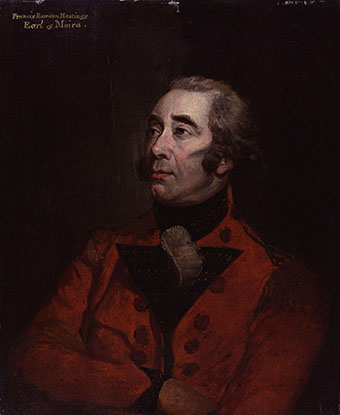Last updated: February 27, 2025
Person
Francis Rawdon

National Portrait Gallery, London
Rawdon, an Irish-Anglo army officer and politician, served the British Army capably during the American Revolution, capping his successful career with a decade as Governor-General of India.
He was born on December 9, 1754, to Sir John Rawdon, first Earl of Moira, and Lady Elizabeth Hastings, daughter of the Earl of Huntington. After receiving his education at Harrow, Rawdon began his military career as an ensign in the 15th Foot Regiment in August 1771. Becoming a lieutenant in the 5th Foot Regiment in October 1773, Rawdon sailed for America in May 1774 and served at at the opening of the American rebellion in Boston.
At the costly British victory at the Battle of Bunker Hill in June 1775, a young Rawdon took command of his company following the injury of his captain. Recognized for his competence, Rawdon was promoted to captain in July 1775 and given his own company with the 63rd Foot Regiment. By January 1776, he was appointed aide-de-camp to General Henry Clinton, serving alongside him during the southern expedition, culminating in the Battle of Sullivan's Island, and in the New York campaign at the battles of Brooklyn, White Plains, and Fort Washington. Clinton became a mentor to Rawdon, sharing his wisdom and promoting his advancement. After capturing Forts Clinton and Montgomery, Rawdon arrived in Philadelphia to deliver the good news to General Howe in October 1777.
By 1778, Rawdon’s mentor Clinton became commander-in-chief of the British North American forces. Rawdon reaped the benefits of his relationship with Clinton when he received an appointment to command the Volunteers of Ireland as a colonel. Rawdon’s role as aide-de-camp to Clinton was also reaffirmed but shortly after, in June, he was appointed Adjutant General while achieving the rank of lieutenant colonel. He commanded his regiment at the Battle of Monmouth on June 28, 1778 as British forces evacuated Philadelphia and marched across New Jersey. By June 1779, relations between Clinton and Rawdon had soured on the basis of Clinton’s criticisms of Rawdon’s Irish volunteers. Rawdon resigned from his position of Adjutant General in irritation.
As efforts turned toward the south, Rawdon joined the Siege of Charleston in the spring of 1780. During the British victory at the Battle of Camden in August, Rawdon commanded Charles Lord Cornwallis' left wing. After the British defeat at Cowpens, Cornwallis moved the bulk of his army north, leaving Rawdon behind to defend both Georgia and South Carolina with a force too small for the task.
Rawdon capably commmanded and resisted Maj. Gen. Nathanael Greene's efforts to eliminate British posts in the interior. On April 25, 1781 Rawdon defeated Greene's army of Continentals and militia with a smaller force at the Battle of Hobkirk's Hill, near Camden. Despite the victory, Rawdon withdrew his men to the safety of Monck's Corner. Greene's strategy of pushing the British back to the safety of Charleston proved effective despite suffering battlefield defeats. In June 1781, Rawdon marched from Charleston with 2,000 soldiers to the assistance of the loyalist outpost at Ninety Six, thereby lifting Greene's siege. Given the vulnerability of the garrison, Rawdon evacuated Ninety Six and withdrew to Charleston with the combined force.
In July 1781, Rawdon was aboard a ship heading to England when the vessel was captured by French belligerents. The ship became part of the French fleet under Admiral Comte de Grasse, and Rawdon became a prisoner. He was eventually exchanged and returned to England in early 1782. Before he had returned home, Rawdon began his term in the Irish House of Commons in 1781, continuing until 1783. In 1783, in exchange for his service in the American rebellion, he was made an English peer (Baron Rawdon). By 1789, Rawdon’s mother had ascended to the barony of Hastings after the death of Rawdon’s brother, prompting Rawdon to add Hastings to his name.
In 1793, Rawdon-Hastings returned to military service to fight against the French. He became the Earl of Moira after the passing of his father, and he was appointed major general. He began his long service in the House of Lords in 1793 as well. An Irish native, he was an impassioned speaker on the issue of reform in the Irish administration and Catholic enfranchisement. He also continued to climb the ladder of military rank. By 1798 he had been promoted to lieutenant general and by 1803 he had been made a full general. In 1803, Rawdon-Hastings became commander-in-chief of British forces in Scotland.
In November 1812, Rawdown-Hastings was appointed Governor-General of India, a position he held from October 1813 until January 1823. His achievements included overseeing victory in the Gurkha War and the purchase of the island of Singapore. He oversaw the extension of British imperial control over India. In 1824, he was appointed Governor of Malta but died off the coast of Italy two years later on a voyage home with his wife. She returned his body to Malta for burial but followed his instructions to cut off his right hand, preserve it, and bury it with her upon her death.
Learn More
Francis Lord Rawdon: Bunker Hill Profile
Sources
Commager, Henry Steele and Richard B. Morris, eds. The Spirit of ‘Seventy-Six: The Story of the American Revolution as Told by Participants. New York: Harper & Row, 1975.
Ketchum, Richard M. Decisive Day: The Battle for Bunker Hill. New York: John Macrae/Henry Holt and Company, 1962.
McCullough, David. 1776. United States: Simon & Schuster, 2005.
Nelson, Paul David. Francis Rawdon-Hastings, Marquess of Hastings Soldier, Peer of the Realm, Governor-General of India. Teaneck, N.J.: Fairleigh Dickinson University Press, 2005.
O'Shaughnessy, Andrew Jackson. The Men Who Lost America: British Leadership, the American Revolution and the Fate of the Empire. United States: Yale University Press, 2013.
